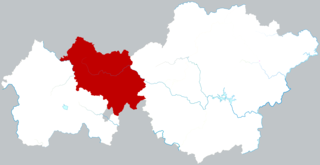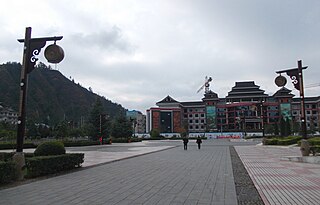
Guizhou is an inland province in Southwestern China. Its capital and largest city is Guiyang, in the center of the province. Guizhou borders the autonomous region of Guangxi to the south, Yunnan to the west, Sichuan to the northwest, the municipality of Chongqing to the north, and Hunan to the east. The Guizhou Province has a Humid subtropical climate. It covers a total area of 176,200 square kilometers and consists of 6 prefecture-level cities and 3 autonomous prefectures. The population of Guizhou stands at 38.5 million, ranking 18th among the provinces in China.

Qiandongnan Miao and Dong Autonomous Prefecture, also known as Southeast Qian Autonomous Prefecture of Miao and Dong and shortened as S.E. Qian Prefecture, is an autonomous prefecture in the southeast of Guizhou province in the People's Republic of China, bordering Hunan to the east and Guangxi to the south. The seat of the prefecture is Kaili. Qiandongnan has an area of 30,337 km2 (11,713 sq mi).

Longlin Various Nationalities Autonomous County is an autonomous county, under the jurisdiction of the prefecture-level city of Baise, in the west of Guangxi, China, bordering Guizhou Province to the north. As of 2019, the county's population was 437,907 people.

Shiqian County is a county under the administration of the prefecture-level city of Tongren, in the northeast of Guizhou Province, China. The government is located in Tangshan.

Butuo County is a county of southern Sichuan Province, China. It is under the administration of the Liangshan Yi Autonomous Prefecture. It was incorporated in 1952, and has continuously existed since 1960. The name 'Butou' is based on the Yi language words for hedgehog and pine tree, giving it the name "a place with hedgehogs and pine trees". It is the unofficial capital of the Yi People and the birthplace of the Torch Festival. The county has a population of 215,800, 97.2% of whom are Yi People.
Xixiu District is a district in the prefecture-level city of Anshun, Guizhou Province, China. The district spans an area of 1,705 square kilometres, and has a population of 765,399 people as of the 2010 Chinese Census.

Hezhang is a county in the northwest of Guizhou province, China, bordering Yunnan to the north. It is under the administration of the prefecture-level city of Bijie.

Leishan is a county in the east of Guizhou province, China. It is under the administration of the Qiandongnan Miao and Dong Autonomous Prefecture. More than 90% of population are ethnic Hmu.
Danzhai is a county in the southeast of Guizhou province, China. With a population of approximately 172,000, it is under the administration of the Qiandongnan Miao and Dong Autonomous Prefecture. The region is renowned for its unique geographic, cultural and ethnic diversity, including the distinctive rice terraces, and Miao ethnic crafts and traditions.

Lushi County is a county under the jurisdiction of Sanmenxia City, Henan Province, the People's Republic of China. It is adjacent to Lingbao City in the north, Luoning County and Luanchuan County in the east, Xixia County in Nanyang City in the south, and Luonan County, Danfeng County and Shangnan County in Shaanxi Province in the west and southwest. It covers an area of 4,004 square kilometers and has a population of 317,232 in 2020. The county government is stationed in Chengguan Town. The county was established in 113 BC. It is the county with the largest area, the smallest population density and the highest average altitude in Henan Province, and it is also a provincial forest city in Henan Province.

New Xiang, also known as Chang-Yi is the dominant form of Xiang Chinese. It is spoken in northeastern areas of Hunan, China adjacent to areas where Southwestern Mandarin and Gan are spoken. Under their influence, it has lost some of the conservative phonological characteristics that distinguish Old Xiang. While most linguists follow Yuan Jiahua in describing New Xiang as a subgroup of Xiang Chinese, Zhou Zhenhe and You Rujie classify it as Southwestern Mandarin. However, New Xiang is still very difficult for Mandarin speakers to understand, particularly the old style of New Xiang.
The Miao rebellion of 1854–1873, also known as the Qian rebellion was an uprising of ethnic Miao and other groups in Guizhou province during the reign of the Qing dynasty. Despite its name, Robert Jenks estimates that ethnic Miao made up less than half of the uprising's participants. The uprising was preceded by Miao rebellions in 1735–36 and 1795–1806, and was one of many ethnic uprisings sweeping China in the 19th century. The rebellion spanned the Xianfeng and Tongzhi periods of the Qing dynasty, and was eventually suppressed with military force. Estimates place the number of casualties as high as 4.9 million out of a total population of 7 million, though these figures are likely overstated.

Wanda Group, or the Dalian Wanda Group (大连万达), is a Chinese multinational conglomerate founded in Dalian, Liaoning and headquartered in Beijing. With regards to the conglomerate's core businesses, the company operates as a private property developer and entertainment company, effectively acting as the owner of Wanda Cinemas and the Hoyts Group line of cinema chains.

Ethnic villages are a basic administrative district within China designated for minority ethnic groups. The villages are designated by the government within geographical regions where minority groups live. The approval and establishment of a village is most often the responsibility of provincial governments and prefectural governments, however villages are often established with different requirement standards. According to a local ordinance regarding the protection of interests relating to minority group villages, a meeting is held where 30% of participants belong to a minority group; if the local government approves of the formation of the new establishment, the region is designated an ethnic village. In Hubei province, villages where minorities account for 50% of the population are designated as minority group villages.

Wanda Film Holding Co. is a cinema operator, film production and film distribution company in China, headquartered in the Wanda Plaza in Chaoyang District, Beijing. It is a part of the Dalian Wanda Group. As of 2014 Wang Jianlin is the head of the company. As of January 2018, Wanda Cinemas remained China's largest film distributor. Some locations are named Wanda International Cinemas with Hollywood and Chinese movies as the main offering.

The Guizhou Rural Tourism Development Center (贵州乡村旅游发展中心), founded in 2006, was then approved by the Guizhou People's Congress as a non-profit organization. It is devoted to preserving, protecting and developing the diverse culture and non-material heritage of ethnic minority groups in southwest China, particularly their beautiful handicraft art. It is also devoted to helping Guizhou's young generation of designers and others who desire to promote ethnic art. Over the years, the Guizhou Rural Tourism Development Center has partnered with many domestic and international organizations, modern designers and young volunteers in seeking to uncover the precious art of Guizhou's many ethnic minority groups, to promote innovative design and to protect this wonderful inheritance.
Sanqiao is a Hmongic language spoken in Jinping County and Liping County, Guizhou, China by about 6,000 people.

Shuanglong Town is a rural town in Huayuan County, Xiangxi Tujia and Miao Autonomous Prefecture, in northwestern Hunan, China. As of the 2015 census it had a population of 29,000 and an area of 155.7 square kilometres (60.1 sq mi).

The concept of Targeted Poverty Alleviation was first raised by Xi Jinping, General Secretary of the Chinese Communist Party (CCP), to combat poverty in China.

Huang Wenxiu was a Chinese Communist Party village official of Zhuang ethnicity. During her time as head of a village in Guangxi, she dedicated herself to poverty alleviation efforts such as promoting economic development and implementing poverty reduction initiatives. Following her death in 2019 from flash flood, the Chinese Communist Party posthumously elevated Huang into a national model for poverty alleviation.















